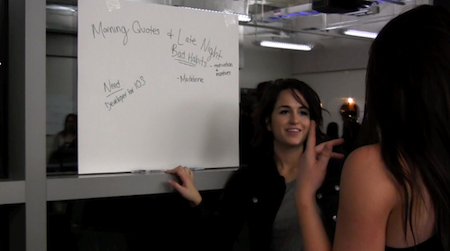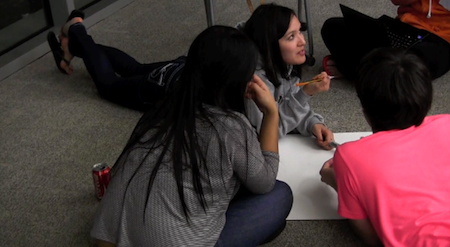|
App development attracts innovative students
- Apps can be profitable and impressive to employers
- Students design apps in CPE 409
- Students design apps for prizes at the Evernote Hackathon
- Successful apps capture a user’s attention
Two Cal Poly students designed and sold the mobile application, Punchd to Google for a rumored ten million dollars in 2011. One was hired by Google, and the other joined a startup app company after graduation according to an article in the Mustang Daily that appeared on Febuary 4, 2013.
Students are catching on to the idea that creating a mobile app and releasing it to the market can be a profitable investment of their time. Building a mobile app showcases a variety of skills that can impress employers.
“Its the latest revolution. Students are interested in what’s hot,” said associate professor David Janzen, who teaches the Andriod application development course at Cal Poly.
 |
Cal Poly Computer Engineering |
Andriod makes a debut at Cal Poly
The idea for Punchd came to fruition in Janzen’s course, CPE 409. He taught the course for the first time in 2010.
At the time, Stanford University had started an iOS app development course that was taught by Apple employees. Janzen wanted to use the Andriod platform because it was newer and different.
“Nobody was really teaching Andriod yet. It had just come out, it was very young. I thought that would differentiate us a little bit,” he said.
Janzen had a contact from Google who helped sponsor the course and provided him with smartphones. He wrote a grant proposal in 2011 to Google and received forty-five Nexus One smartphones for the course.
Students paired in groups of two or three and brainstormed ideas. Sponsors judged the apps at the end of the quarter and students received prizes.
“It’s a very hands-on course. I teach them specific skills like how to create a user interface, how to put a button there, how to put a text box, how to store things in a database, how to connect to the internet, how to display a Google Map and integrate that,” Janzen said.
Standing out from the crowd
It’s not essential that students learn mobile development, Janzen said. They have the programming skills to do it on their own but by teaching a class he gives them the justification to spend time on it. Students work as teams, solve problems and meet deadlines in the context of a classroom, he said.
“The value that I bring to them is helping them when they’re stuck, explaining things to them and giving them feedback on their app,” Janzen said.
One problem is standing out in a sea of billions of apps. Students have good ideas, but they often resemble apps on the market already, Janzen said. He encourages them to make it better than what is already offered.
“It has to captivate the user’s attention. It has to be extremely useful. It meets a need or it captures your attention in some creative way. It delights you, it surprises you,” he said.
One successful app designed in the course was the SLO Bus Tracker which gives route information in real time for the San Luis Obispo transit, he said.
 |
 |
Students brainstorm app ideas at the Evernote Hackathon |
|
Hacking all night
Students who want to build apps can do so in CPE 409, or participate in competitions like the Hackathon.
The computer engineering department and Evernote, a suite of mobile apps and services that archive notes, pictures and links, hosted the Evernote Hackathon on February 15, 2013 in the Bonderson Engineering Center on campus.
Students spent twenty-four hours brainstorming, learning skills and finally pitching a mobile app to Evernote developers.
Computing allows students to explore and implement ideas quickly, Janzen said. Many other projects in the engineering department require weeks of research, but applications can be developed in twenty-four hours, he said.
“The fact that a company is doing something here and they are looking for one, good students, and two, good ideas-there is a lot of interest by companies,” he said.
Engineers, graphic communications and computer science majors all gathered on Friday evening to form teams at the Hackathon.
Evernote Developers discussed the itinerary for the weekend, had students brainstorm ideas, and served pizza and refreshments.
“I’m looking forward to the experience, making something tangible and that you can use yourself and maybe put out there on the market,” said Calvin Wong, a computer science sophomore.
The grand prize
Wong’s team worked on a GPS based application where once users arrive at a specific location, they could open a portal to media and notes that friends leave behind pertaining to that location.
Students envisioned apps that could:
-
store favorite quotes
-
simplify rent and utility payments
-
help freshman tour the campus
-
organize your closet
Kristen Yeh, a graphic communication major, and her team designed MobileCloset, an app that catalogues outfits and shares them with friends. The app won for best overall design effort in the competition.
“Basically you take pictures of clothes that you buy and save them in a virtual closet where you can scroll through photos.” Yeh said. “Once you have your outfit on you can save them in a look book and refer to them later.”
Evernote awarded developers for best overall app, best design, and best technical development. Prizes included gift cards, moleskin notebooks, an iPad mini and the Nexus 7 tablet.
Surely the most valuable prize of the weekend was networking with Evernote developers who have positions open on their team. Skills demonstrated over the weekend can land participants a job.
“We are always looking for new talent we love working with students we value both design and engineering. We like to see the collaboration, we’re excited to be here at Cal Poly,” said Jason Jones, Product Designer at Evernote and Cal Poly graphic communications alumni.
The best overall app award went to Eventuall, a collaborative photo sharing stream for events. The best design went to Ambler, that targets high school students as they begin their college touring process |
| |
|
|
©2013 Alyse Schember -This is a multimedia interactive website produced in a journalism course at California Polytechnic State University, San Luis Obispo.

|
|

